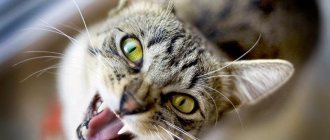When getting a pet, everyone understands that they will face a number of difficulties. However, few people think about the “mating season” of future pets. This topic deserves special attention; preparation is indispensable. So, what to do if the cat goes on a spree? The most important thing is not to panic.
It should be remembered that the animal senses the owner’s mood. Many people begin to think about how to get rid of the animal, because it is such a hassle. There is no need to show weakness, all problems can be solved. The main thing is to know how to do it. Having all the necessary information, you can help both the cat and yourself.
Possible reasons for the disappearance of a cat
If the cat left home and did not return, this means that he most likely died.
It is known that these animals anticipate death in advance and prefer to face it alone. This is one of the laws of the wild, and cats adhere to it. But there are other possible reasons for this action:
- These pets feel not only their death, but also the misfortune that threatens the family that sheltered them. Therefore, when leaving home, the cat takes the blow upon itself, averting misfortune from the people dear to it. In this case, the search will not be successful.
- A cat who has never been outside can easily get into trouble the first time he goes outside. If the owner does not find him in the next couple of days, he may die under the wheels of a car, from hunger or cold.
- Animals that are familiar with walking are also not always able to protect themselves from enemies, and become victims of hooligans or packs of dogs.
- An animal can leave the house if one of the family members hates it.
- In the spring, following the call of sexual instinct, the mustachioed friend may disappear for a long time. Usually he returns after a couple of weeks.
- In some cases, a furry pet, carried away by the chase, may find itself in an unfamiliar place, far from home. In this case, it will be difficult for him to find his way back, but in most cases the animal is able to return to its home, although not soon.
Has the cat gone on a spree or not?
First, you need to understand what is happening to the pet. Cats are independent animals, it’s not for nothing that people say: “A cat walks on its own!” They love their owners and are devoted to them, but at the same time they always keep their distance. People have to be extremely attentive to their pets.
Less than a year after birth, cats become sexually mature and begin to walk.
Now they are able to mate. We must remember that males are ready to meet a female at any time . Is your pet acting strange? Some signs that a cat has gone on a spree:
- the animal behaves aggressively towards its owners and other pets;
- the cat marks the territory;
- obsessive desire to leave the house, take a walk;
- screams inviting a female;
- frequent urination.
© shutterstock
If your cat goes on a spree for the first time, it is advisable to contact a veterinarian. A competent specialist will tell you how to behave in this situation, and most importantly, how to calm the cat. Professional advice and guidance is always needed. After all, we are talking about a living being. Any mistake can harm the pet and add problems and troubles to the owners.
How to prevent escape
To avoid losing your beloved pet, it is enough to take a number of necessary measures:
- If the animal is not intended for breeding, then it must be sterilized or neutered. Now in any veterinary clinic this harmless operation is performed under anesthesia. As a last resort, you can use special drops and tablets that suppress sexual desire. But, as practice shows, they are often ineffective or lead to the development of serious diseases.
- For cats and breed-class cats, special conditions of detention must be provided. The male and female usually mate at least twice a year.
- You should not let your pet go for walks on its own. They are possible only if the family lives in a private house with a high fence with complete protection from the penetration of other animals.
- In the city it is better to walk your pet on a leash. Cats of any breed can easily get used to wearing a harness if you start training from an early age (from three months).
- To prevent your pet from falling out of the window, it is necessary to install special anti-cat protective nets. They protect animals from falls much more reliably.
- There should be a friendly and respectful attitude towards the cat in the house. If she is being starved, there is poison from cockroaches all around, or there is constant screaming and fighting in the house, then she will definitely leave.
- It is necessary to monitor the front door to prevent your pet from escaping in time.
What is estrus and when does it start?
Estrus in a cat is a natural physiological phenomenon, indicating that the furry lady has begun sexual hunting, she is ready to mate with the cat and become a mother. Just like with people, cats have everything individually, including the timing of their first heat and its duration. The normal duration of estrus is 5–10 days, but can vary within this norm. The first heat usually occurs when the cat is physiologically mature and her reproductive system is fully formed. On average, this occurs at the age of 7–9 months, although science knows cases when a cat entered into sexual heat as early as four months of age. The following factors will help you more accurately determine when your furry friend will first begin to suffer from amorous suffering:
- breed - in large and long-haired cats, such as the Maine Coon or Norwegian Forest, puberty occurs later, at approximately 9–16 months; in Siamese cats or Orientals, distinguished by their graceful physique, estrus can occur as early as 5–6 months;
- genetics - if the cats in your pet’s family matured early, then the first heat will probably begin a little earlier;
- birth season - it has been noticed that cats born in the spring become sexually mature somewhat earlier than cats born in the fall;
- Dimensions - cats with a large build mature later than cats with a normal build; Exhausted or physically underdeveloped cats mature even later;
- length of daylight hours - the shorter the daylight hours in the room where the cat lives, the later the sexual heat begins;
- feeding and housing conditions - a balanced diet contributes to the full development of the reproductive system, therefore the first heat occurs a little later.
You should not bring your cat to her “groom” during her first heat. The not fully formed reproductive system of a teenage cat is not yet ready for pregnancy and the birth of cubs. Pregnancy that is too early can have a negative impact on the health of both the cat herself and her future kittens. There is also a possibility that a cat that is too young will simply abandon its litter, and then the worries about the furry babies will fall entirely on your shoulders. Experienced breeders say that the optimal age for the birth of the first kittens is 1 year.
The best age for a cat to give birth to her first kittens is 1 year.
It is optimal if 3–4 heats after previous births do not end in fertilization. Such heats are called empty. And yet, every medal has two sides. If in the future you do not plan to bring your pet with a cat, then it would be better to sterilize her and not torment either yourself or the animal with empty heats. The more empty heats follow in a row, the faster the next period of sexual heat begins. Frequent and prolonged estrus negatively affects not only the owner’s nerves (constant cat “concerts” can drive anyone crazy), but also the cat’s health and psyche. During heat, the four-legged lady experiences extreme stress, and this is not good for anyone. In addition, frequent empty estrus leads to hormonal imbalances, diseases of the reproductive system and even oncology.
How can you determine that this difficult period will soon begin in the life of your pet - estrus? The cat itself will “tell” you about this:
- “concert on demand” - the most obvious sign of the onset of sexual heat in cats is, of course, loud, drawn-out screams designed to attract a male;
- “Stroke me completely!” - the cat begins to rub against the furniture and legs of the owners, trying to leave its smell everywhere;
- “look at the posture” - he takes a specific pose, crouching on his front paws and sticking out his butt - it is in this position that mating takes place;
- “water treatment time” - the genitals are enlarged during the period of estrus, there is a light transparent discharge, which forces the cat to lick itself more often;
- “potty” - urination becomes more frequent, the cat visits the litter box more often;
- “lunch break” - the appetite, slightly increased before the heat, may disappear almost completely;
- “I’m not in a good mood” - the cat’s behavior also changes: depending on its character and temperament, the cat becomes unusually affectionate or, conversely, unsociable and aggressive;
- “promenade” - even cats that have never been outside try to escape from the house during heat, so be careful when opening the entrance doors or leaving windows open;
- “Hide your slippers” - a cat can give its owners such an unpleasant surprise as territory marks.
However, you should not punish the furry lady for her tricks, because she is under stress and does not do all this to spite you. As a friend and owner, you must help your pet and provide her with support during this difficult period.
When do cats start walking?
Many owners are interested in how long a cat walks, because this period cannot be called pleasant. The cat constantly purrs and screams - the owners are guaranteed sleepless nights at this time. In addition, some individuals, not finding a male, even try to run away from home. But, before answering the question regarding the duration of estrus, you should understand at what age it begins.
The time at which cats go into their first heat is influenced by the onset of their puberty. It is impossible to say exactly when your pet will begin her first estrus period. Everything is purely individual. But on average, a cat’s first ovulation occurs at 6-8 months. But for some it may be a little later - by 1 year.
The onset of puberty is influenced by various factors. For example, the size of the pet, its breed, the presence of a cat nearby. The age at which cats start estrus for the first time even depends on the season and color of the animal.
But, as a rule, the first estrus in cats normally begins before the age of one year. Later is considered a deviation. If your pet is over a year old and still hasn’t started to come into heat, you should contact your veterinarian. The animal probably has some kind of disease or hormonal imbalance.
It also happens that a cat’s sexual heat practically does not manifest itself; this condition is called “erased estrus.”
As a rule, it is typical for sick and weakened animals. Erased estrus can also occur in completely healthy pets that have little temperament. In any case, your pet should be shown to the veterinarian.
How to return
If the search for the missing animal does not bring results, you can turn to rituals.
- Place your cat's favorite food in his bowl. Then you need to light a white candle, place it next to the bowl and leave it overnight. After this, you need to turn to the Universe and ask it to return your pet safe and sound.
- Take a full glass of clean or holy water and place it next to the front door. Then imagine as vividly as possible how the pet returns and crosses the threshold of the house, and say: “Name of the cat, come to me, visit me.”
- Tie all four legs of the dining table with rope. The result will be something like a magical bait trap. All we have to do is wait.
- You will need a candle. At midnight you need to light it, stand at the open window and shout: “Smoke free, my cat to the house.”
If cats disappear because the brownie kicks them out, then you need to appease the latter. Make an offering - a piece of sugar and a glass of milk. And when you bring the cat into the house, say:
If the pet came into the house on its own, then this is a good sign. However, only in the sense that the pet returned to the house. There is nothing mystical here, although if the cat left because of negativity in the house, then the return of the pet may mean that the atmosphere in the home has returned to normal, and its residents are no longer in danger of trouble.
Whenever the cat returns, you should never think that the fluffy one brought something bad with him - this does not happen. This sign has only good meaning.
If a lot of time has passed and the animal has not returned, then you need to release it. This is necessary to calm his soul. Thank your pet and say goodbye to him.
Pets: how many days does a cat walk?
It is useful to know how many days a cat walks, and how to alleviate this period, which causes a lot of inconvenience for the animal and the owner. There are both drastic measures to solve the problem of animal estrus, and more loyal ones, which are less expensive both in time and financially. All that remains is to choose which option is suitable for your pet.
Signs of estrus in an animal
Before we begin to consider the question of how long a cat walks for the first time, and what effective measures exist to alleviate this period, it is necessary to understand in general what this condition is. And how do you even understand that your pet has begun this period?
The concept of estrus is also called estrus. During this period, psychophysiological changes occur in the pet’s body: follicles begin to mature in the ovaries, ovulation occurs, and accordingly, the animal can become pregnant.
Certain signs indicate that an animal has gone into heat. Therefore, in order to know how to determine estrus, you need to familiarize yourself with them. So, how cats walk:
You can tell about estrus by clear discharge in the genital area, which is why your pet will lick itself much more often.
If a cat goes on a spree, its appetite may decrease or even disappear. This symptom is especially evident in the first days of estrus. However, it is possible that problems with appetite may accompany the entire period of estrus.
The gait changes. If a cat has been on a spree, it will bend its front legs and raise its pelvis slightly, while moving its tail unnaturally.
To know when to expect the signs previously mentioned, it is important to know at what age pets go into heat. In cats, on average, this period occurs in the first six months of life.
In such male animals, sexual activity is
Source
What is estrus?
The word "estrus" is the scientific name for estrus. During estrus, psychophysiological changes occur in the body. Follicles mature in the animal’s ovaries, ovulation occurs, and conception becomes possible. During estrus, your pet's behavior changes noticeably.
The following signs indicate that a cat is walking:
- The pet becomes overly affectionate, or, conversely, shows inexplicable aggression.
- Meows loudly and invitingly. During estrus, a cat can call for a male for days. Read the article “Why does a cat constantly meow and yell throughout the day?”
- Frequent urination due to physiological changes in the body.
- The presence of clear discharge on the genitals. Therefore, your pet will lick itself more often.
- There is also a decrease in appetite. For some, interest in food may disappear altogether. This condition can occur in the first few days of estrus. Although some people may experience worsening appetite throughout the entire estrus phase.
- The genitals may be slightly swollen. But often only an experienced veterinarian can recognize this.
- Changes in gait. The cat bends its front legs halfway, raises the back of its body, lifts its tail or moves it to the side.
- The cat may begin to mark its territory.
These signs can be observed alternately or in combination.
Treatment with hormonal drugs
The heavy artillery in the fight against basic instinct is hormonal drugs. Such medications can be purchased at a pet pharmacy without a prescription or at a veterinary clinic. It is advisable to consult a doctor before consuming such serious drugs. Hormonal drugs are quite dangerous, and if taken regularly, the risks of developing chronic diseases increase.
Many experts say that drugs in this category are not the best way to solve the problem of how to calm a cat. The thing is that hormonal pills and drops do not always act effectively and quickly. An alternative option is injections. Injections will definitely silence the cat, but at the same time they are even more dangerous for the pet’s health. It is worth noting that the cost of injections is quite high.
I want to castrate my cat, but will it help...
Subsequently, the craving for this wall will disappear.
Scaring sound. Foil around a favorite spot will make the cat afraid. Subsequently, he will think ten times whether to mark or not.
Unpleasant sensations. To call them, you can use double-sided tape. If you paste it around the usual marked place, the pet will stick every time it wants to leave a mark.
Creating favorable conditions for the animal to live. The cat must be fed and happy. The toilet must be kept in good condition. Every few months, your pet needs to undergo a preventive examination by a veterinarian to prevent various painful conditions. Ideally, keep the male without competitors, then there will be no need to mark the bed of his owner out of jealousy.
General information about castration
Castration is a surgical operation to remove the testicles (testes) of a cat. This is the only procedure that guarantees control over a cat’s sexual desire and related problems.
The operation is performed under general anesthesia, which requires certain preparation.
Even if the cat looks absolutely healthy, 2 weeks before castration you need to carry out parasite prevention and show your pet to a veterinarian.
Before castration, the cat must receive a full course of vaccination or revaccination.
The veterinarian examines the cat for breathing and heart problems. If the doctor has any doubts, he will recommend contacting a veterinary cardiologist.
The cat's blood must be taken for analysis. Contraindications for the use of anesthesia are:
Reduced hemoglobin - indicates anemia, which can cause severe complications when recovering from anesthesia and rehabilitation after surgery.
Rapid erythrocyte sedimentation indicates oxygen starvation of cells and low immune defense of the body. Red blood cells carry blood throughout the body, and their rapid sedimentation indicates rapid death.
An increased number of leukocytes may indicate an infection or virus that is already attacking the cat’s body. Anesthesia will significantly reduce the body's immune defense, which will allow any illness to develop into an acute form.
To tolerate anesthesia normally, the cat must be healthy and have an adequate weight for its build. The veterinarian will prescribe a diet for your cat if he is obese or malnourished. In the second case, if the weight loss is not caused by a serious illness, the situation is a little simpler. The cat needs to be kept on a diet rich in carbohydrates, and after the operation, transferred to a special food for emaciated animals. In the case of obesity, weight loss should occur gradually. Too sharp burning of fat tissue literally poisons the body with decay products.
How to behave in this situation
There are different ways to solve the problem if your pet goes on a spree. It all depends on the owner, what he is ready for, what he puts at the forefront: the health of the animal or his own peace of mind? When making a decision, you should weigh the pros and cons.
The first way is to set free
When a pet goes on a spree, it loses its appetite and constantly tries to escape outside. Holding an animal all day without taking any measures is very difficult. A cute, fluffy and kind pet suddenly stops responding to the calls of family members, does not hear anything, only screams heart-rendingly under the door, dreaming of jumping out at the first opportunity. The simplest and easiest way is to simply open the door . After some time, the cat will return happy and calm. But there is one drawback - along with a good mood, it can bring a whole bunch of diseases. You will have to treat until your next spree.
The second method is medications
Some cat lovers may use special medications. The veterinarian must examine the animal and prescribe medication based on the characteristics of the particular pet. Such drugs are usually available in the form of drops or tablets. Drops are more convenient to use; tablets must be mixed with food. In this way you can suppress the sexual instinct of cats. It has not yet been established what consequences their regular use may lead to.
Sometimes they give a hormonal injection. For six months, the cat will lose interest in the opposite sex and stop going for walks.
© shutterstock
The third method is castration
The main task of every owner is to help their pet. What to do when the cat goes on a spree at home? The most popular method is castration. This is a surgical procedure to remove the testes. A cat should be castrated only if there is no desire to have offspring. This procedure is best performed at the age of 8 – 15 months . The operation is considered simple and, as a rule, does not cause complications. After the operation, you need to make sure that the cat does not lick the wound and carry out regular treatment with iodine. For many owners, castration is the best option, although not very pleasant.
How to understand that a cat has started walking
As a rule, an experienced owner will easily understand when his beloved cat has begun to mark its territory and look for its loved one. It should be understood that pets can walk at any time of the year, unlike street cats. The reason is that the pet is always warm, safe and does not experience any problems with food, which means that everything predisposes it to having offspring.
Usually there is no estrus for more than 7-10 days. However, after it has passed, and the cat itself has not taken a walk, do not think that you have ensured peace of mind for a long time. Within two weeks, the heat will begin again.
The behavior of a cat during heat is extremely characteristic and can rarely be confused with anything else. If you've never gone through something like this before, here are the obvious signs:
- the animal becomes extremely affectionate and constantly rubs against its legs;
- begins to meow very loudly - almost scream;
- she stopped going to the litter box, and now absolutely everything serves as a toilet for her;
- takes a mating position: moves its tail to the side and bends its front legs.
Be careful, because even the calmest and most timid pet completely changes during heat and is capable of leaving the apartment by any means - these are instincts and you cannot argue against them.
Puberty
Males reach sexual maturity a little later than females. So, if a cat becomes ready to mate at the age of 5-6 months, then males become ready to mate from 9 to 12 months. There are cats that mature by the age of two, and this depends on many factors - diet, the presence of an animal of the opposite sex in the house, genetic characteristics.
Factors determining the period of onset of puberty:
- breed affiliation;
- skeletal structure (elegantly built pets with a fine bone structure, mature earlier than their more powerful relatives);
- season;
- habitat;
- predisposition at the genetic level.
The time when a cat matures for procreation is marked by the beginning of marks. The animal begins to mark the territory in which it considers itself the rightful owner. It is rare, but it happens that a cat does not mark the room in which it lives.
The period of intensification of sexual desire usually occurs in the spring. But cats, unlike cats, can mate all year round. This is due to the fact that males have their own specific periods of activity, depending on the individual characteristics of the body.
Duration, frequency and manifestations of estrus in cats
The first heat in cats usually comes at 8 - 10 months, and for some even earlier. But the pet is not yet ready for kittens to appear at this time. The burden of bearing kittens is too great for a body that is not fully formed and can result in health problems and premature pregnancy. The animal will be ready for kittens no earlier than 16 - 20 months. In an adult cat, without problems with the reproductive sphere, estrus occurs three times a year and lasts about 10 - 14 days. In some cases, longer, it depends on many factors and characteristics of a particular case.
When a cat asks a cat how to calm her down, it’s not immediately clear. During this period, her behavior can be more than specific. The main symptom is loud, obsessive meowing, which can last continuously with breaks for short-term sleep. In general, at this time, pets are characterized by increased nervousness and even, possibly, aggressiveness, which is manifested by damage to things.
In addition, the desire to meet a cat can manifest itself as follows:
- the cat marks the territory, leaving small puddles;
- there is a decrease in appetite;
- adopting a mating position, rolling on the floor;
- excessive affection, the animal literally sticks to its owners.
If these signs make it clear that the cat wants a cat, what to do needs to be decided as soon as possible, and it is better to take care of this issue in advance. Otherwise, you will have to “enjoy” heartbreaking cat concerts for more than one day, without a break for the owner’s sleep and rest. And even the fluffiest purr will not benefit from such stress.
There are enough tools that can cope with the problem. The most obvious of them is to give the animal the opportunity to satisfy its desire. But perhaps this is not always the case. After all, not all owners have the opportunity and desire to adopt several kittens every year. In this case, it is worth turning to other means, which we will consider.
How long and often do cats walk?
Many owners are concerned about how much the cat walks and how often. It is difficult to give specific answers to these questions. Each representative of the cat family will have its own indicators. In addition, several factors influence the duration and frequency of estrus.
How many days a cat's heat lasts depends on:
- environmental conditions, season;
- conditions of detention;
- feeding characteristics;
- animal breeds;
- age of the cat;
- presence of contacts with cats;
- physiological characteristics of the pet’s body;
- health status.
True, there are averages. From 5 to 10 days - this is how long the estrus lasts for a cat living at home. But everything is individual. In rare cases, estrus can last up to 20 days. The first heat is most often short-lived and becomes longer over time. So, the number of days a cat walks for the first time does not mean that her estrus will continue to be of the same duration. The hormonal background has not yet fully formed.
It is recommended to observe how many days the cat is in heat, because sometimes it can be too long. And prolonged estrus is a pathology. Similar situations can occur with an ovarian tumor or cystic process. It is highly undesirable to start such diseases. Therefore, it is important to know how long a cat’s heat is normally. And in case of deviations, contact a veterinary clinic in a timely manner. The doctor will perform an ultrasound, take blood samples and, if necessary, prescribe a treatment regimen.
Sometimes it happens that the cat does not leak at all. This may be the cause of the development of some disease. Therefore, a visit to the veterinarian cannot be avoided. If the cat does not start walking, experienced breeders advise taking the following measures:
- If there is another cat who is currently in heat, she should be placed with a pet who is not starting to walk. Often cats leak at the same time. And the second one may also leak.
- If you have a cat, it is advisable to place it with a cat. The smell of a cat can cause hormonal changes in the pet's body, and the pet will begin to walk.
- You can give your pet vitamins and homeopathic remedies. Naturally, on the recommendation of a veterinarian. This method is only suitable for healthy cats.
The question of how long a cat’s first heat lasts is clear. But how often does the animal walk? As for frequency, if the cat has already given birth, then, as a rule, estrus occurs once every few months. Sometimes the interval can reach a year. But if your pet has not given birth before, estrus may bother you more often. For example, monthly or even every 2 weeks. As for stray animals, as well as older individuals, their estrus usually occurs in the fall or spring.
The question of why a cat often walks is understandable. But what to do in this situation? The best option is to give the animal the opportunity to reproduce regularly. Thus, it is possible to achieve that the heat will occur once every six months. But it is worth noting that a cat’s first heat after giving birth may appear after just 1-1.5 months. If the owner does not plan to breed cats at all, it is worth contacting a veterinarian. The animal can be sterilized. Or the doctor can choose hormonal drugs.
Useful materials:
- Cutaneous horn General description of the disease Cutaneous horn on the forehead or face (ICD 10 code - L57.0) -...
- Itching and odorless discharge Main causesBefore considering the factors that provoke the appearance of discharge that has a sour odor, it is necessary to immediately note...
- Normal temperature in animals Normal temperature in different types of animals Veterinary services Day hospital for animals Veterinary certificates Vaccination…
- Discharge in women What kind of discharge between menstruation is considered normal? Female discharge normally consists of mucus from the cervical canal, dead...
Does the surgical area hurt due to castration?
In most cases, no noticeable pain reaction develops, but it may be indicated by a change in the cat's behavior. Most veterinarians believe that an animal over four years of age should be given sedatives for the first two days after surgery to relieve discomfort in the groin area. Most likely, the post-operative wound is very painful if you observe the following signs:
- The cat snarls and hisses every time you try to probe the area of the post-operative wound. Do not be offended by your pet: he is in a lot of pain, and therefore restless behavior and aggression are his only way to show how severe the pain is.
- The pet completely refuses even the most delicious food.
- The cat half sits and half lies on its stomach, its limbs are tightly tucked together, the animal looks intently at one point and reacts with obvious reluctance to any external stimuli. This behavior indicates very severe pain that requires immediate relief.
The role of painkillers
The role of pain medications is much more important than is commonly thought. Thus, they not only improve the quality of life of the operated animal in the first hours and days immediately after castration, but also help improve appetite (if the cat is not in pain, he will eat much more willingly)
Consequently, sedatives help normalize metabolism faster, and this is extremely important
In addition, severe pain impairs the normal functioning of the endocrine glands, kidneys, lungs, heart, liver and other internal organs. Again, painkillers help prevent this. Finally, these medications normalize the cat’s behavior: if the animal does not experience pain, it will be much more adequate.
Cats (precisely cats) have one physiological feature. When the pain is severe, they often develop a powerful spasm of the urethral canal, as a result of which the pet is physically unable to pass “little by little.” In this case, the cat becomes nervous, irritable, can spin in one place for a long time, and constantly pushes. Despite all the efforts made, the animal manages to squeeze out only a couple of drops of urine. As a rule, 1/6 of a No-Shpa tablet helps, but you should only give it yourself as a last resort. If possible, call a veterinarian: one injection of antispasmodics can completely solve the problem.
As a rule, the animal eats little and does not drink too much during this time. In addition, the body compensates for fluid loss, and therefore less urine is produced. It is much worse when a cat constantly and profusely pees due to castration. Polyuria in this case may be a sign of kidney damage due to incorrectly selected agents for local or general anesthesia.
If you notice that your pet is constantly using the litter box, but is acting normally (i.e., he is not showing signs of pain characteristic of urethral spasm), be sure to tell your veterinarian.
There is no need to try to alleviate your pet’s condition using the arsenal of your home first aid kit. It is unlikely that you will be able to relieve the pain, but you will certainly be able to cause serious damage to the cat’s health (or even kill him).
The fact is that painkillers are developed based on the characteristics of the biochemistry of a particular type. And it just so happened that the bodies of cats and humans are different in many ways. In particular, paracetamol, which is one of the most common painkillers in medicine (and fairly safe for humans), can easily kill your cat. Or cause severe pathologies of the hematopoietic system, which is no better than a quick death. So don’t take risks, and a cat’s strange behavior is always a “good” reason to call a veterinary specialist.
Drug treatment
Today, veterinary pharmacies offer several types of medications that can eliminate the symptoms of estrus. Veterinarians advise avoiding too frequent use of such products, since they contain a high concentration of active substances, which negatively affects the cat’s body.
Medicines have a negative effect on the animal’s reproductive system, artificially causing inhibition of natural processes in the body. They often lead to the formation of breast tumors and the development of malignant neoplasms of various localizations.
The listed consequences of taking drugs, most of which are made on the basis of hormones, make them undesirable methods for eliminating the manifestations of estrus.











